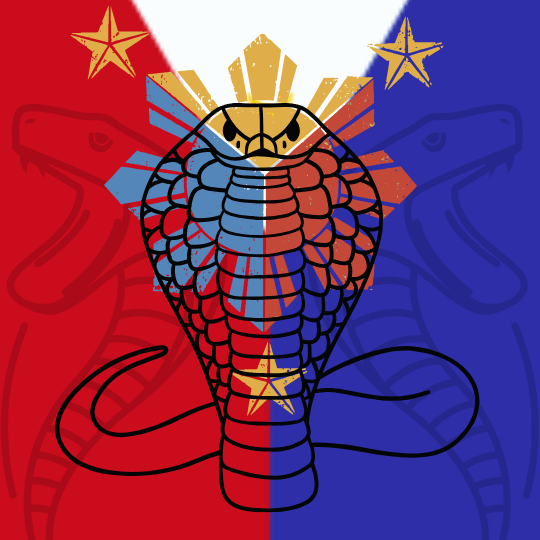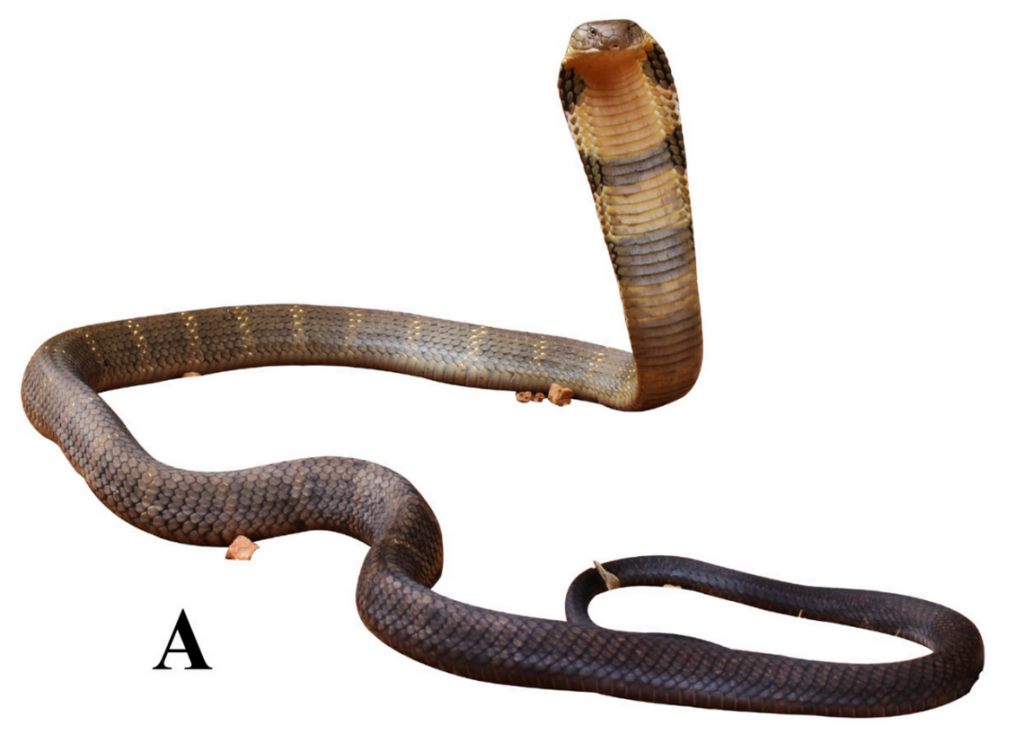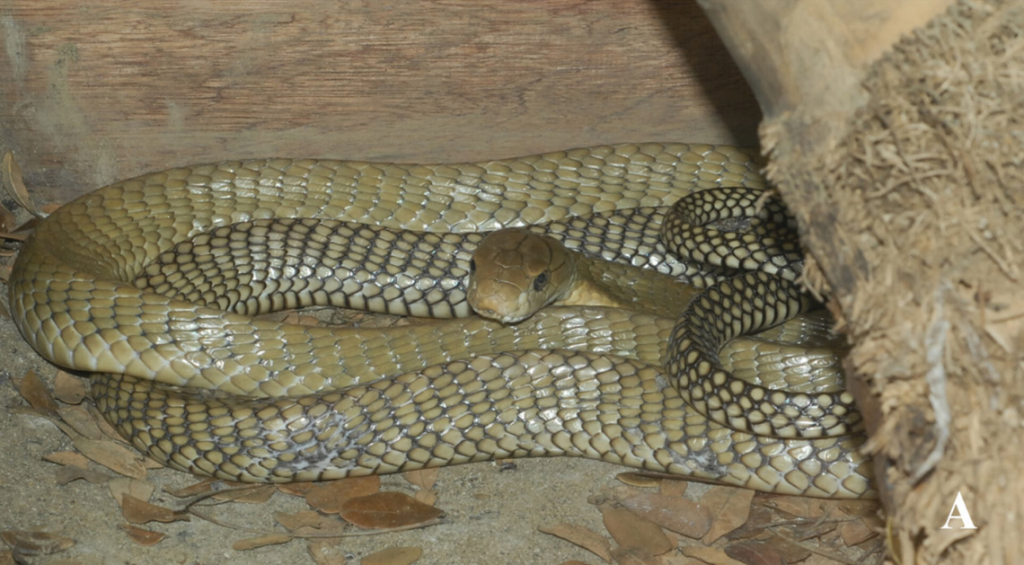
Three New King Cobras on the Block
As of October 16, 2024, there are three new king cobras added to what was once a singular species under the king cobra umbrella. They are the:
Ophiophagus bungarus
Ophiophagus kaalinga
Ophiophagus salvatana
Thisis in addition to the primary species identified as the main king cobra species: Ophiophagus hannah.
This news is exciting to reptile enthusiasts all over the world!
The Luzon King Cobra (Ophiophagus Salvatana)
Of the three new king cobras, I am most interested in the Luzon king cobra.
The Luzon King Cobra has long been associated under the scientific name “Ophiophagus hannah”. With the new discovery of it being a distinct species, it is now reclassified as “Ophiophagus salvatana”.
King cobras from the Philippines are genetically and most importantly, visually distinct, as they lack the banding that is most commonly found in all the other king cobra species. They are paler in comparison to the other species.
Although it may display some banding when it is young, it eventually loses it and takes on a pale yellowish gray color all throughout its body with the color gradation shifting from light gray near its head to darker gray on its tail. The edges of its scales are also gray which gives it that distinctive look.
The Luzon King Cobra is exceptionally large and may reach lengths of 10 to 11 feet. They have robust bodies, large flattened heads with a notable depression medially. They also have large eyes ringed with yellow and black tongues.
They are also dangerously venomous.
Aside from the salvatana, the Ophiophagus bungarus is also present in the Philippines. Only the salvatana is exclusive to the PhIlippine islands.
That means that the Luzon king cobra is endemic to the Philippines.
Nowhere else is it found in the world, making it a special type of king cobra found only in the Philippines.
And that’s what makes it so special.
Disclaimer Time!
Just a disclaimer: the term banakon is a collective term for almost all cobras in the Philippines. But to be more specific, the term banakon is most probably associated with the species Ophiophagus bungarus instead of the Ophiophagus salvatana based on the distribution of the snake in the Philippines.
My Personal Experience with Banakons
To be honest, I didn’t believe that the banakon existed in the first place because of all the anecdotes I heard about the snake in 2014 – 2015.
Eyewitnesses would describe the snake as black with red eyes and a red tail that would stand up as tall as a person and knock on doors to get in.
Back then, my experiences with cobras were the ones where I was able to assist in milking one as a school activity, seeing a few small common cobras in the wild and that one time when a girl asked me to take in a cobra that they were keeping as a pet.
Except for the one that I assisted in milking, all the cobras I mentioned above were small. Barely reaching 5 feet in length with the smallest one at barely 2 feet.
And back then I had the common sense not to mess with any of them.
They were fascinating creatures, but I instinctively knew how dangerous they were despite my young age.
To this day, the only instances where I came close to a banakon were those times I visited the Davao Crocodile Park where they have one on display behind a glass case and seeing them from a very safe distance on the farm as they slithered away from me.
And even then, I still have doubts if what I saw was an actual banakon or just a really dark brown or rat snake.
After all, I am not an expert on king cobras and/or other venomous snakes.
Let’s Dispel Some Myths About Banakons
Only recently did I actually see videos and photos of king cobras in the wild or handled by experts who catch snakes to relocate them from barangays that need help dealing with snakes.
A visual confirmation of the look and size of the snake in the video told me that king cobras or banakons do exist in the Philippines. If what I suspect is true, based on the distribution of the snake and how it looks like, what we have in Mindanao are the Ophiophagus bungarus species.
They Don’t Chase People Over Long Distances

King cobras or mostly any other snake for that matter are shy creatures. They would much rather get away from you than deal with you. First, we’re too large to be prey items to them. If they do manage to kill us, they wouldn’t be able to eat us which to a snake is a terrible waste of energy.
Second, save for the black mamba, we could easily outrun any snake if we really wanted to. Most snakes top out at 12 kilometers per hour (kph). An average adult can run 13 kph. And snakes expend energy too quickly making them tap out faster than us.
But what a banakon will do is strike if they feel threatened or chase you away from a sensitive area like their nest. That short spurt of speed is going to seem exceptionally astounding. These are fast snakes. But they will drop the attack once you are away from the area they don’t want you to be in.
They’re Not Black as Sin
Their general color is black but they do have a very distinctive pale yellow belly that offsets that black color.
Sometimes, when fear takes over, black is the one thing we remember the most because we associate it with death and danger. Black and red. Which brings us to the next item: king cobras do not have red eyes.
King Cobras Do Not Have Red Eyes
Fear. It does strange things to us in our minds.
But I will say though that there is a red tinge in some cobras’ eyes based on how yellow or near to the orange hue their eye coloration is.
They Don’t Stand Up Straight Like a Rod
King cobras will rear their heads. Since it can raise almost a third of its body they may appear to stand like a human being. A third of an 18 foot king cobra is after all, 6 feet. The average Filipino height is 5’4” to 5’5” for men and 5 feet for women.
Standing up straight like a rod would make it impossible for the snake to balance itself because they would have a smaller footprint if they used the tip of their tail in the same manner as our foot.
I believe this myth came about from eyewitnesses who saw a king cobra rear up forcing their focus on the raised body and not on the supporting body on the ground.
Their Tongues are Not Venomous
Snakes will dart their tongues in and out of their mouths to taste the air around them. That is not the venomous part of a snake. The venomous parts are the fangs that inject venom.
They are Not Vengeful
One of the cruel myths I have heard about snakes in general here in the Philippines is that if you kill one, you better make sure to cut off its head and dispose it properly far away from its body.
This is to prevent any passing snake or “relative” of the snake to look into the eyes of the deceased snake and see a reflection or visual imprint of the person who killed it.
Once the snake sees who killed the dead snake, they will go out of their way to hunt the perpetrator and kill him or her.
The only animal I now of that has been confirmed to be vengeful is the tiger.
They Don’t Knock on Doors
One of the funniest things I heard about banakons was their ability to knock on the doors of their intended victims. They would basically use their heads to knock three times on your door. When you open it without asking who’s on the other side, they’ll strike at you and leave you dead because of your carelessness?
Maybe this has some truth to it given that a king cobra will strike multiple times. Maybe someone managed to hold an object in between their person and the snake and the strikes sounded like knocks on the door. If they survived that encounter and told it to other people, then it could possible be retold in a different variation over time leading to this myth.
Or it could be a tale told by parents to their children to warn them about opening the door for strangers especially after dark.
It’s a funny anecdote and I continue to laugh inside my head every time I hear it from an “eyewitness”.
They Do Not Go Out of Their Way to Eat Humans or Young Children

This is most probably another story told by a parent to a child to dissuade the latter from going near any snake.
A king cobra’s main diet primarily consists of other snakes. And then rats, chickens, small pigs, small goats, other small livestock, frogs, birds, anything small enough that can fit in their mouth without too much effort.
They can eat things bigger than their heads because they can dislocate their jaws but a human being is far from ideal prey given that we have wide shoulders.
So, kids, stay away from snakes because they could bite you. Just remember to tell your parents that you were bitten if you played with one and an accident happened. Just stay away from snakes if there are no adults around.
King Cobras Do Not Fly
King cobras hood up. To some, this flattening of the ribs may look like the animal has just unflapped its wings and is about to take flight.
Don’t worry they won’t fly.
But, get as far away as you can because you could still be within their striking distance. King cobras are surprisingly fast and can cover a lot of ground with their strikes.
I think I’ve covered most of the myths connected to king cobras. If I missed anything, feel free to send me an email through hayopetc@gmail.com or here.
Now let’s move on to the Ophiophagus bungarus which is most probably what is known as banakon in the Philippines.
Sunda King Cobra (Ophiophagus bungarus) (or What I Suspect is the Banakon)
The Sunda King Cobra is found in extreme southern Thailand, West Malaysia, Singapore, and offshore islands), Sumatra, Borneo, Java, Bali, and some of the islands of the southern Philippines Archipelago.
It gets its name from having krait-like characteristics making it a mean snake if cornered.

Based on its geographical distribution, characteristics and visual appearance, the Sunda King Cobra is most probably what we, in the Philippines, call the banakon.
Sunda King cobras are dark brown to black with light banding. Have darker yellow bellies with a tinge of gray giving it somewhat of a translucent look. Dark pigmentation can also occur along the cobra’s underside giving its belly a mottled look.
I guess this guy: Herping Honza – Mindanao Reptile Enthusiast seems to think the same thing about the banakon being the Sunda King Cobra too.
But wouldn’t it be swell if the banakon happened to be another species of king cobra upon further investigation of its DNA and genetic lineage?
If that happens, I hope they’ll call it the “Ophiophagus banakon”.
Western Ghats King Cobra (Ophiophagus kaalinga)
Like the Luzon King Cobra, the Western Ghats King Cobra is a robust, flat-headed snake that can reach up to 10 and a half feet in length.

The difference lies in their coloration. Where the Luzon king cobra is pale, the Western Ghats or kaalinga is dark brown to olive with several pale bands on its back that fade as they reach the tail. It also has a dark red tongue.
This species is found in India’s Western Ghats which is the reason why they have that name. this is a hill-dwelling species that can also be found in the forested lowlands of the surrounding areas. Their diet consists mainly of other snakes, most especially pit vipers and other king cobras.
Their scientific name is based on the Kannada word “kali” meaning black and the abbreviation of the name Kaalinga Havu which is a reference to the Hindu God Shiva.
How Three New King Cobras Came About
This announcement of there being three new king cobras is not an overnight discovery. In fact it is a study that has spanned over two decades with increasing focus on identification of the different species over the last few years.
This study was based on the examination of 148 specimen. Let’s say 150 just to make it a good rounded off figure.
These new announcement of three new king cobras is the first significant change on the taxonomic description of the animal king cobra. Whether this split will have any significant change to its classification as an endangered species will come about is anyone’s guess.
I’m leaning towards there being more stringent measures to protect these king cobras as dividing them into four distinct species means that the population base of each one is divided from the greater whole under the Ophiophagus hannah umbrella.
Just imagine, the king cobra was established as Ophiophagus hannah in 1836. It took 188 years before any significant changes were made to it.
And that was yesterday October 16, 2024!
It’s such a cool time to be alive!
We need to thank the research team for making such an effort. The research team includes: Indraneil Das, P. Gowri Shankar, Priyanka Swamy, Rhiannon Williams, Hmar Tlawmte Lalremsanga, P. Prashanth, Gunanidhi Sahoo, S.P. Vijayakumar, Jacob Hoglund, Kartik Shanker, Sushil Dutta, S.R. Ganesh, and Wolfgang Wuster
You can find the official research paper here.
Hopefully the proper identification of these three new king cobras will also lead to more specific developments in anti-venom made available to the regions where the three new king cobras are found.
Ophiophagus Hannah Renamed from King Cobra to Northern King Cobra
So, the Ophiophagus hannah has not been eradicated with this new discovery. They are still a distinct species from the three new king cobras in the most recent announcement.
What has changed is the geographical distribution of this species from being the only known species representative of all the areas where king cobras are found to just Extreme Eastern Pakistan to Cambodia and parts of Thailand.
The Introduction of Three New King Cobras Gives Us More Reason to Protect Them
I hate to end on a sad note especially if the majority of the article is based on how exciting it is to have three new king cobras as separate from the collective term of king cobra under Ophiophagus hannah.
But the sad reality is that their numbers are declining in the face of habitat destruction and degradation, capture for food, skin, medicine, killing out of ignorance and fear.
Especially here in the Philippines where the initial reaction to a snake, whatever snake it may be is to kill it. I hope more people strive to educate those who need it so these beautiful can survive for generations to come.
We can do our part by reading up on the subject and reaching out to experts in the field like the King Cobra Conservancy.
We can also start by filling out this form: Protect the Cobra: Report a Cobra




2 thoughts on “Goodbye King Cobra, There are Three New King Cobras in Town”